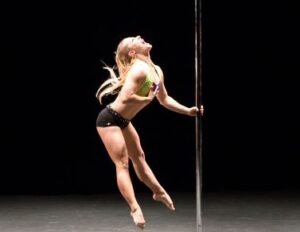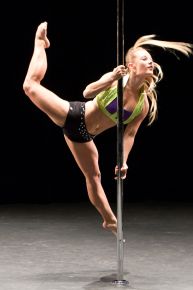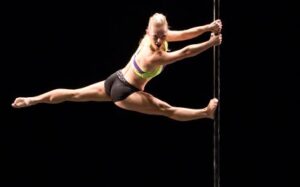An Interview with Blondie
 From weightlifting, ballet and an addiction to pole dance; Blondie is a fantastic performer that shows clear versatility through intention and choreography. Her biggest inspiration is her fellow pole dancers who, as a community, build each other up and give each other the motivation to carry on. I bet this is a familiar feeling to all of our pole readers? I’m sure you’ll all relate, in some way or another, to this interview. So here it is…
From weightlifting, ballet and an addiction to pole dance; Blondie is a fantastic performer that shows clear versatility through intention and choreography. Her biggest inspiration is her fellow pole dancers who, as a community, build each other up and give each other the motivation to carry on. I bet this is a familiar feeling to all of our pole readers? I’m sure you’ll all relate, in some way or another, to this interview. So here it is…
Tell us a bit about yourself.
I grew up in Santa Cruz, California, and started dancing when I was 7 years old. It was the only activity my mom could get me to participate in that I didn’t throw a temper tantrum at!
I ended up being pretty dedicated to ballet for the next 2 decades, and found pole 3.5 years ago when I moved to San Francisco. By that time I had gotten really into weight lifting, and pole dance looked like the perfect combination of dance and strength. I remember being covered in bruises after my first class, in pain all over, and desperate to do it again!
When did you choreograph your first piece of work?
My first pole performance that I choreographed was for the Pacific Pole Championships in 2013. I think I had 2 pole tricks in the whole thing because just that was so challenging back then. But the best part of putting the routine together was all the support I had from my instructors and co-competitors, and that is still true today. It’s wonderful to be on stage and share yourself with an audience, but the 99% of the journey happens off stage, in the studio, working it out with your pole family.
What tends to stimulate your creative thoughts?
I get inspiration from all sorts of places. A lot of times movies or songs that I’ve connected with inspire me to develop characters to bring to life on stage. Other times it will be something more personal that I’m going through in my life, and a song will feel like a life raft I’m clinging to in order to get through that time.
How do you think your experience as a professional dancer/choreographer has informed your pole practice?
It has been such an unexpected gift to be put in the “pro” category for pole dancing. It pushes me to be better for my students as well as for myself, but if anything, is just a daily reminder of how much I have left to learn. I have been blessed with so much support and love from all the dancers around me; right now I’m working on paying that forward so that others can get as much enjoyment out of this sport as I have.
What is your favourite part of the creative process?
I love every part of it for different reasons. The initial brainstorming process in the beginning is fun, because you get to imagine yourself as this incredible athlete and artist, before reality sinks in about how much work it will take to achieve that vision. I love the pole jam sessions with my friends, where 99% of the time is spent making mistakes, acquiring new bruises, and laughing at your crazy ideas, and the 1% where things actually work and make it all worth it. And then of course, the shows. I love being in front of audience. It feeds my soul. Being on stage in front of hundreds of people is this incredibly vulnerable, terrifying moment. It’s letting all your insecurities and strengths be highlighted under bright lights, alone, on a stage. It’s both intimate and powerful, and totally addictive.
 What do you find most difficult about choreography and how do you overcome this?
What do you find most difficult about choreography and how do you overcome this?
I’ve learned through a lot of trial and error, that if something doesn’t seem to work to you, it isn’t working for your audience either. Change it to the most authentic thing you can do in that moment.
Who is your biggest inspiration and why?
I really want to make a big list of every pole star that I’m obsessed with, because that’s part of it. But more than that, it’s the pole dancers I see every week. My text messages are mostly from my pole friends, constantly boosting each other up, sending pics of the latest trick, or their pole accomplishment that day. This sport just gives and gives and keeps giving, because it attracts the kind of people that want to support one another. Pole success is not a limited resource; the more we encourage one another, the better we all become.
What, if any, do you think are the psychological benefits of creating your own work?
Creating things makes me happy. I love seeing the finished result; it’s a reminder that I can do anything I want, as long as I work hard for it.
Can you tell us how you prepared your work “cool” and what your process was like?
My “Cool” performance at NWAAC last year was really special for me. There’s so much powerful emotion going on behind Cool; it’s about bursting to the edges with energy and feeling, and still needing to keep your shit together. It’s how I feel every day. The creative process was just that; deciding whether to lash out or play it cool. That piece is also so high energy, a lot of the behind the scenes work was about pushing my limits as an athlete.
What comes first during your process, the pole or the floor movement?
Both. It’s all just movement.
Since creating your first solo, how do you think you have grown as a choreographer?
I’ve definitely become a lot stronger, and the best part of this is that now my end result matches more closely with my vision. When I plan my routines, I have a little voice that says “you’re a super hero, you can do all these things!” and then I start to choreograph and that little voice goes “okay, wait, you’re still a human. Maybe do this instead!”
 If you could give readers a piece of advice for creating their dance, what would it be?
If you could give readers a piece of advice for creating their dance, what would it be?
People who dance just for themselves will disagree with me on this one, but something I love considering is, how am I going to connect with my audience? How do I stay true to myself and still involve the audience in this moment of expression? When I watch dancers get on stage who are so nervous or wrapped up in their piece that they can’t make eye contact with those watching them, it makes me sad. I want to yell at them “Include me! Let me in!” Let your supporters be a part of that vulnerability.
If you were hiring a dancer to perform your work, what would you look for in them?
I love working with people who are fearless. Be courageous, try new and scary things. You might fall, it might hurt, but use a crash pad and pain is temporary. Don’t expect to produce quality work if you keep telling everyone “I can’t” all the time.
What sort of time frame do you give yourself to create a new piece of work?
I really start putting in the work about 8 weeks out from a show. This gives me about a month to make a rough outline of what I want the piece to look like, 2 weeks to solidify it, and 2 weeks to rehearse it until I could dance it in my sleep. It’s also a short enough amount of time that I don’t get bored with the dance, my music, or the creativity. But it will be different for every artist.
What does pole dance do for you?
Pole dance fills a hole in my heart that I didn’t even know was there. Some days I think to myself, how did I LIVE before pole? Our bodies are the only things that are really ours, and pole dance allows me to use everything mine has to offer; my emotions, my strengths, my weaknesses, my movement, my pain, my joy. It takes everything I have, and then gives it back tenfold.
If you want to see more of Blondie, you can find her on instagram or visit her website.
If you love reading about choreography and the creative process of pole dance. You can enjoy “Speaking through Movement” an eBook available for for purchase worldwide on Amazon.




No Comments